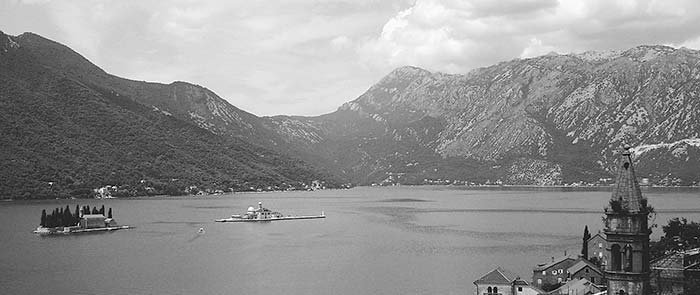
Crna Gora
Small and rugged, Montenegro gets overlooked. It’s tucked in a rocky and complicated part of the world between Croatia, Serbia, and Albania. And yet, it sits just a temptingly short drive away from the region’s top destination, Dubrovnik. Today’s Montenegro is a strange mix of big-money international investment (Russian-owned luxury resort hotels, the exclusive Porto Montenegro yacht harbor) and challenging local poverty (which is evident as you pass through ragtag cities and humble towns). But nothing can mar Montenegro’s natural beauty: Devote a day (or more) to making this easy side-trip, and you’ll discover a land of stunning mountains, bays, and forests.
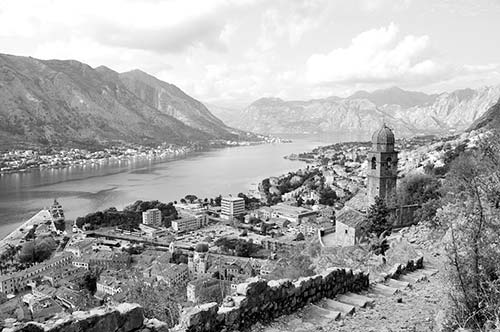
Where to Go: Most people see Montenegro as a quick side-trip from Dubrovnik—which, for those on a tight timeframe, is a smart plan. The main highlight (and the focus of this chapter) is the Bay of Kotor, with scenery that only improves on Croatia’s Dalmatian Coast, some fine seaside towns (including tiny Perast and atmospheric Kotor), and the chance to ride out to a church-topped island in the middle of the bay, wrapped in 360 degrees of stunning scenery. With more time, beach bums can head for the Budva Riviera; celebrity-seekers can daydream about past glories at the striking hotel-peninsula of Sveti Stefan; and romantics can corkscrew up into the mountains to sample the Balkans’ best smoked ham at Njeguši and visit the country’s remote original capital at Cetinje.
Getting Around: Most visitors simply drive in for the day from Dubrovnik—using their own rental car, hiring a Dubrovnik-based private driver (listed in the “Dubrovnik” section on here), or joining a package tour. Be aware that Google Maps navigation is not available in Montenegro. Montenegro is also relatively well-served by buses (for connections to and from Kotor, see www.autobuskastanicakotor.me). It’s also a popular and easy cruise port—ships put in right across the street from Kotor’s Old Town.

Montenegrin Cuisine: Along the Bay of Kotor, the cuisine is similar to Croatia’s—that means seafood, pasta, and pizza. Njeguški pršut is the rich, salty, smoky prosciutto from the village of Njeguši (described later) that goes well with the local cow’s cheese—smoked, of course. Montenegro also produces some surprisingly good wines (Plantaže Podgorica is the biggest company): A good red is the dry, medium-bodied vranac (related to zinfandel), and for white, you’ll see the dry, fruity krstač (similar to Riesling).
Montenegrin Language: Montenegrin is closely related to both Croatian and Bosnian. “Hello” is Dobar dan (formal) or Zdravo (informal); “please” is molim; “thank you” is hvala; and “Goodbye” is Do viđenija. You’ll see both “our” Roman alphabet and the Cyrillic alphabet used, more or less equally; for a crash course in Cyrillic, see here.
The following sections are designed to get you started planning a trip to Montenegro. For in-depth coverage—including a self-guided driving tour, detailed hotel and restaurant listings, and lots of practical advice—pick up my Rick Steves Croatia & Slovenia guidebook.
For a look at the untamed Adriatic, take a spin on the winding road around Montenegro’s steep and secluded Bay of Kotor. The area’s main town, also called Kotor, has been protected from centuries of would-be invaders by its position at the deepest point of the fjord—and by its imposing town wall, which scrambles in a zigzag line up the mountain behind it. Wander the enjoyably seedy streets of Kotor, drop into some Orthodox churches, and sip a coffee at an al fresco café.
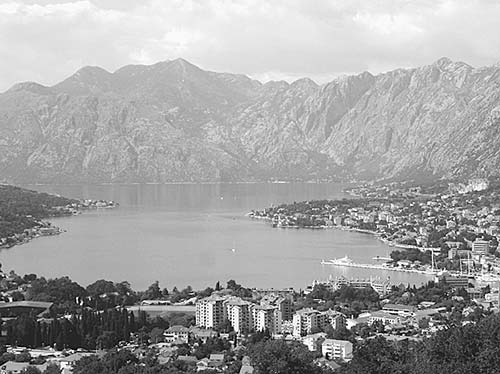
Visiting the Bay of Kotor: Most people do a loop around the Bay of Kotor in one day from Dubrovnik. Here’s the basic plan:
From Dubrovnik, head south on the main coastal road (signs to Ćilipi), past Cavtat and the airport; in about 40 minutes, you’ll reach the border at Debeli Brijeg (where you’ll need to show your passport and your rental car’s proof-of-insurance “green card”). To avoid lines at the border, get an early start—on busy summer weekends, consider leaving Dubrovnik by 7:30 to beat the tour buses. (There’s also a less crowded alternate border crossing called Konfin—ask locals for directions.)
Once across the border, you’ll head through the big, dreary city of Herceg Novi, then curve around the headland at the Verige Strait—the quarter-mile-wide entrance to the huge, fjord-like bay (underlining Kotor’s strategic importance). From here, you’ll curl along the bay’s waters—through crescendoing scenery and tiny towns—until you reach the village of ▲ Perast. Park, stretch your legs, and explore this tiny, well-preserved town (with a big waterfront main square and a half-built cathedral).
From Perast, pay a few euros per person to be shuttled out across the bay for a closer look at a pair of islands: St. George (Sv. Đorđe) and ▲▲ Our Lady of the Rocks (Gospa od Škrpjela). It’s said that two local fishermen saw a light emanating from a reef deep below the surface near the isle of St. George. Discovering an icon of Mary, they were inspired to build a second island on that holy spot. So, for two centuries, locals dropped rocks and even sunk old ships there—eventually creating the island of Our Lady of the Rocks. You can stroll the island and dip into the church, filled with votives honoring the miraculous icon that was found here.

Back in Perast, get back on the road and carry on around the bay about another 30 minutes until you reach the town of Kotor; with more time, you can continue farther to the Budva Riviera, or head up into the mountains and Cetinje (all described later).
To return to Dubrovnik, just head back the way you came. Or, for a shortcut (and to see different scenery), you can continue around the bay past Kotor, then continue all the way around to Lepetani, where a frequent and easy ferry (trajekt) travels a few minutes across the bay to Kamenari—near Herceg Novi and a short drive from the Croatian border.
Butted up against a steep cliff, cradled by a calm sea, naturally sheltered by its deep-in-the-fjord position, and watched over by an imposing network of fortifications, the town of Kotor is as impressive as it is well-protected. Though it’s enjoyed a long and illustrious history, today’s Kotor is a time-capsule retreat for travelers seeking an unspoiled Adriatic town (www.tokotor.me). For a good local guide, contact Stefan Đukanović (www.miroandsons.com, djukan@t-com.me).
Visiting Kotor: You can see the entire compact Old Town in a short stroll. Pass through the Main Town Gate (with a TI kiosk) and into the Square of Arms, fronted by a grand old palace and the town’s bell tower. From here, get lost in the twisty lanes.
Make your way to the ▲ Cathedral of St. Tryphon, with its mismatched towers, fine interior, and quirky treasury collection (featuring an icon that, like Montenegro itself, seems to merge Eastern and Western Christian traditions). Just off the cathedral square, you can dip into the Maritime Museum of Montenegro, with modest exhibits on the bay’s history and seafaring traditions (www.museummaritimum.com).
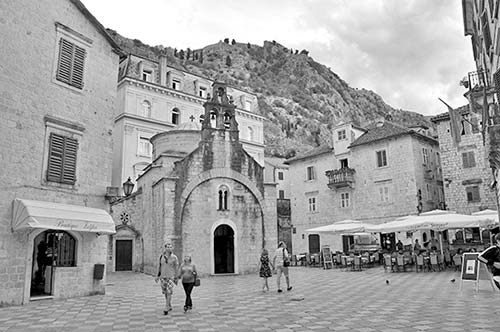
A few lanes over, ▲ St. Luke’s Square has two Eastern Orthodox Churches—one big, one little. Either offers a fascinating look at the Eastern Orthodox faith (see here).
Kotor’s main attraction—for those who are fit enough to tackle it—is climbing the ▲▲ city walls that climb up the sheer cliff face behind town in a dizzying zigzag line. (If there’s a more elaborate city wall in Europe, I haven’t seen it.) This involves climbing 1,355 steps (an elevation gain of more than 700 feet)—don’t overestimate your endurance or underestimate the heat. Find the ticket desk and trailhead at the back-left corner of the Old Town (near St. Mary’s Church, through the alley with the two arches over it). Then get climbing, following a clockwise route that ascends to the Church of Our Lady of Health (the halfway mark), then all the way up to the Fortress of St. John. Allow at least an hour and a half round-trip, wear good shoes (uneven and rocky footing), and bring plenty of water and sun protection.
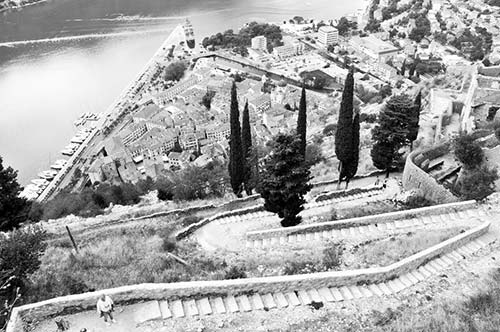
Sleeping in Kotor: I’d rather bunk in Dubrovnik—Kotor is pricey and can be noisy after dark. But if you need a bed, consider the stony-chic $$$ Hotel Villa Duomo (www.villaduomo.com), the businesslike and super-central $$$ Hotel Vardar (www.hotelvardar.com), or the affordable $ D&Sons Apartments (www.dandsons.com).
Eating in Kotor: City Restaurant has solid, basic food and outdoor tables next to the cathedral. Cesarica offers unpretentious seafood in a casual, stony interior buried deep in the Old Town (Stari Grad 375). And for a wine tasting or to browse bottles to take home, drop by The Old Winery (Stara Vinarija, at Stari Grad 483).
A 15-mile stretch of coarse-sand and fine-pebble beaches run along the coastline about 30 minutes south of Kotor. This “Budva Riviera” is unappealingly built up with a mix of cheap and luxury resort hotels. But the seafront is inviting, and the main town, Budva, has a charming Old Town crammed with souvenir shops and holiday-making Serbs and Russians. Two churches (Catholic and Orthodox) face each other near the town’s imposing (but empty) citadel.
The main draw along the Budva Riviera is the famous hotel island of ▲ Sveti Stefan—which hovers like a mirage just offshore, about a 20-minute drive south of Budva. Once an actual, living town (connected to the mainland only by a narrow, natural causeway), Sveti Stefan was converted into a luxury hotel in the 1950s. Its promise of privacy attracted celebrities, rock stars, royalty, and dignitaries—from Sophia Loren to Kirk Douglas to Sly Stallone. More recently, it was again renovated into a super-exclusive, €1,000-plus-a-night Aman Resort (www.aman.com). Only paying guests (no exceptions) can actually enter the island, but anyone is free to gaze over it from the road above, or to rent a pricey chair on the beaches that flank its causeway (there are a few free beach areas—ask the guard for pointers).
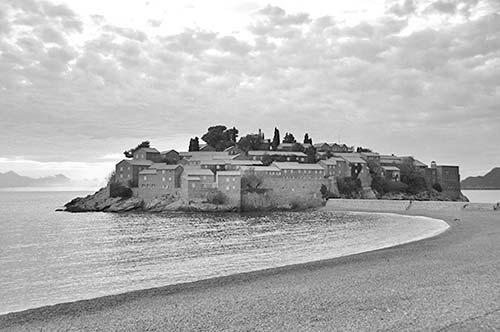
While the coastline gets all the buzz, the true heart of Montenegro beats behind the sheer wall of mountains rising up from that seafront. From near Kotor, an almost comically twisty road spirals up, up, up to the village of Njeguši—famous among Montenegrins for two reasons: as the hometown of the House of Petrović-Njegoš, the dynasty that ruled Montenegro for much of its history (1696-1918); and as the birthplace of Montenegrins’ favorite food, the smoke-cured ham called Njeguški pršut (sold by various restaurants in town).
From here, the road winds across a startlingly desolate landscape to Cetinje—the now-humble historic capital of Montenegro. Stuck in an economic rut, Cetinje tickles romantic historians but has few tangible sights. On its main square are a collection of small museums, and nearby—marking the birthplace of the town—is the local monastery, dedicated to a charismatic local priest who famously carried a cross in one hand and a sword in the other, established the first set of laws among Montenegrins, and inspired his people to defend Christian Montenegro against the Muslim Ottomans.

Even higher up from Cetinje, a winding road heads up to the mountaintop monument called Lovćen, which is capped by an elaborate mausoleum—designed by the great 20th-century Croatian sculptor Ivan Meštrović, and devoted to King Petar II Petrović-Njegoš. From here, you can ogle the grandiose statues of a long-forgotten dynasty and, in the turn of a head, see a significant percentage of Montenegro.